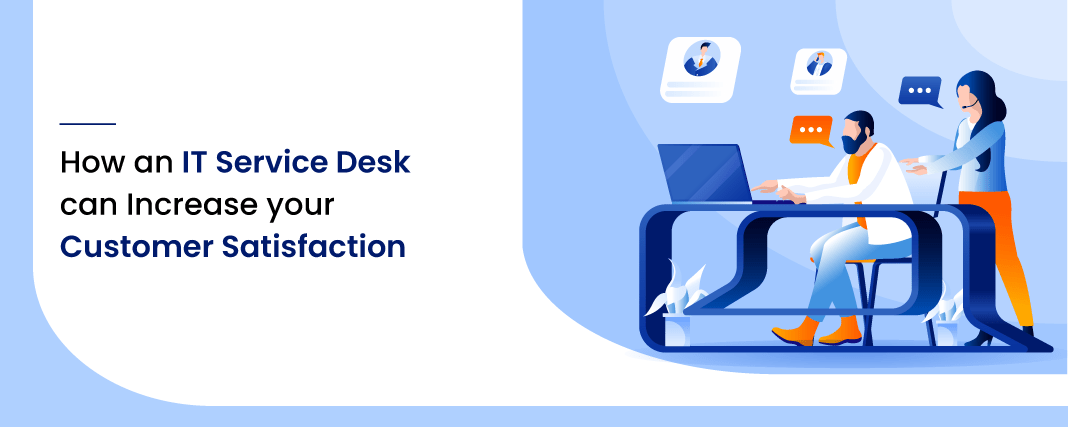IT helpdesk is an essential touchpoint for any IT-based organization. It is the interface that links any IT company with its end-users, and related beneficiaries and agencies. An automated work environment becomes possible only when an efficient IT service desk works behind the scene. By many names, such as call center, customer care center, tech support, etc they are mostly involved in the same function; however, their scope is different.
Role of IT service desk in an organization
Companies dealing with the customers through online mediums or those offering backend support to the businesses need a dependable IT desk to deliver critical values.
Accordingly, some of the conventional roles that the IT desk performs in the work ecosystem of such businesses are:

1. Complaint resolution management
Complaints are part and parcel of any service-oriented organization. Cloud computing has turned the software also into a service; thus, the companies need to be well-prepared to tackle all types of problems that are likely to occur in such customer-business relationships. The role of complaint resolution management encompasses:
- Fixing downtime issues of internet-based services or applications, also known as incident lifecycle management.
- Solving any breakdown issue of a machine or software-based tool
- Remote resolution of disruption in the promise of service delivery
- On-site deployment of service staff to tackle crucial operational issues
a. Fixing downtime issues:
A website showing error messages and suffering server and downtime issues can rub the customers the wrong way. It can hit the business image badly. With the help of the IT service department, businesses can avoid occurrences of such incidents. The IT cell takes cognizance of such incidents on priority and settles them before the problem blows up to unwanted proportions.
b. Solving machine breakdown issues:
You can better understand the role of an IT cell when a newly deployed network of devices stops working. The IT cell takes stock of the situation remotely and tries to offer timely solutions to retain customer faith and interest in the product. It is the IT service unit that gives any user confidence that they are in safer and capable hands. The IT helpdesk helps resolve customer issues faster by:
-
- Providing warranty-related information
- Fixing software bugs remotely
- Offering replacement according to warranty plan or AMC
- Suggesting modes of solving the hardware issues through quick chat and robots
c. Remote resolution of issues:
A fully digitized business has software at the core of its work environment. Take an example of a bank whose operations come to a halt due to the system failure. IT service cell with the tools like FTP sharing, remote server check, and remote rebooting of servers, etc. can enable the service-based organizations to keep working despite the incident.
With the remote support, the IT cell tries to mitigate the effects of system failure, allowing the end-users of the service to continue enjoying the offerings uninterruptedly. By employing research and expert consulting, the experts use the process of incident lifecycle management for the development of better service models.
d. On-site deployment of service staff:
Depending upon the cruciality of the nature of service or a product, IT service companies can have a support staff deployed on-site.
2. Acquisition of new customers and entering new markets
IT service desk can be the most prominent tool for entering new markets using an automation-centric approach. The desk helps deliver the service that creates a positive buzz about the company.
The way the IT helpdesk improves the customer experience and enables organizations to have better control using the self-service portal. It is a kind of facility that speaks about the readiness of the customers with respect to a company or business. A single positive word of mouth, with its ripple effect, can create more markets where consumers are eagerly waiting for some technical breakthrough to happen.
IT service cell helps achieve the acquisition of newer markets with the help of:
- Automation & AI/ML application
- Training
- Creating self-service portals
- Data analytics support
a. Automations and application of AI/ML:
IT service cell is the in-house technical expertise that the businesses can employ to achieve better products and service designs of more yielding nature. The use of advanced solutions like AI/ML makes it easier to accomplish objectives. This is achieved with the employment of these tools by experienced technology experts in the market development process. With the help of data analysis and predictive modeling enabled by AI/ML applications, businesses can mold their offerings according to the challenges of newer markets and come up with more customer-centric solutions.
b. Training:
IT service cell is of great help in implementing new ideas for the acquisition of more modern markets. Training programs, developing white papers and user manuals, and time-to-time updating of user knowledge are some of the advantages that IT cell offers to businesses. Using these positives, the companies prepare new customers for the adoption of innovative technology and prove its relevance.
c. Creating self-service portals:
An IT helpdesk plays the role of creating better understanding and constructive interaction between the two. The self-service portals and the explainer videos that the IT department develops can take the customer experience a notch higher and allow users to enjoy better ownership over the technology.
d. Data Analytics support:
An IT cell is the storehouse of data. Customers contacting the IT service cell and sharing their concerns and experiences form invaluable data. The companies can use this data generated from IT cell’s interactions in developing the analytical models that ultimately transform the business as per the expectations of the new markets and consumer bases.
3. Achieving seamless SLA management
The SLA is a commitment to the delivery of service that a provider makes to its end users. It has three essential aspects – availability, responsibility, and quality. Thus, a product or service should be capable of being available to the customers and be fully responsible for delivering quality of experience to them.
First Aspect:
-
- The very first aspect of SLA is quality. By quality, we mean the quality of service and that of user experience. IT helpdesk allows solving end-users’ issues by letting them do corrections or resolutions of minor nature.
Second Aspect:
-
- The second point worth knowing about is responsibility. The IT service helpdesk portrays a responsible image to offer a sense of security to the businesses’ end-users. They provide the cover for security by documents like secrecy codes, privacy policy, data security solutions, SSL certificates, etc.
Final Aspect:
-
- The final aspect is the availability. The IT service desk has to commit to being available to the businesses that are employing innovative solutions. They do so by intimating the end-users of service catalog updations, new service code and AMC updations, and ticketing systems. They assign the escalation hierarchy and ensure that each ticket, whether fresh or aged, has ended in a successful resolution.
What makes a Service Desk helpful?
Customer experience is all about putting them first, the way they want, exactly when they need it. An SLA agreement ensures the meeting of all these requirements of customer experience. With the help of a well-developed service architecture comprising of following features, the IT cell equips the businesses to create consumer-centric experiences:

Service desk management
- A professional attending to the customer queries and resolving the issues at the earliest possible can be a source of ultimate delight to the business’s end users.
- The service desk management, these days, achieves a high quality of delivery with the help of tools like embedded buttons for WhatsApp, SMS, Get a Call Back, and so on. These tools take service desk management to another level and help the companies plug all the loopholes in the service even before the customer mentions it to others.
- Robotics enabled service desk management is another interactive solution that allows businesses to understand and address the issues and solve them in real-time.
Maintenance of ticketing system
- Assigning a docket number to each query or complaint seems very simple but has profound implications. It allows businesses to track and solve the issues the earliest possible. An automated escalation system enables the front end executives to get a senior’s support when needed. The customer receives the great service that is a collective outcome of teamwork happening behind the ticketing system.
- If the end-users could solve the problems with the self-service portal, the ticketing system acts as the first level. It ensures that the system is completely service-oriented.
Customer management
- Customer management does not involve solving customer complaints only. It starts right from the time of customer acquisition. IT support department helps the company see the opportunity of expansion or foraying into a new market. Next, it helps the quicker onboarding of the customers and creates the first finest experience. It is the completeness of involvement that makes an IT helpdesk a primary instrument in customer issues’ management.
- Familiarizing the clients with the self-service portal is another underrated aspect of customer management that has a more substantial impact on a business’s performance in reality. A self-service portal can make sense only when the IT cell has taken pains to train the customers to use it. The self-service environment helps multiple ways.
- First, it maintains the privacy of the end-user. Second, it helps build the image of business as that of being user-friendly. And most importantly, the self-service tool brings immediacy in the delivery of solutions, which is quite crucial for surviving in a highly competitive present world.
Service catalog maintenance
- The service catalog is the most promising tool that can empower any business to deliver high-quality customer service. The IT professionals pour their expertise in the service catalog and explain the usage, maintenance, shelf-life, device lifecycle maintenance, and several other topics in the most comprehensive manner. It does not stop here. The IT cell further expands the scope by ensuring modifications in the service catalog.
- Thus, the service catalog becomes a true testament to a company’s commitment to delivering core SLA values. It simply transfers more power to the hands of end-users and makes them exceptionally comfortable with the solution that the business strives to develop and provide.
To sum up,
Customer experience is a collective of high-quality products, excellent customer service, and future-readiness of the solutions that the companies develop. An IT helpdesk has its say in all the departments in some form or the other. Calling an IT service cell the front face of any business is not an overstatement, given the kind of impact it creates on the consumer-business operations. Do you wish to suggest something new to us? We would love to hear it from you!
Need Any Technology Assistance? Call Pursho @ 0731-6725516




